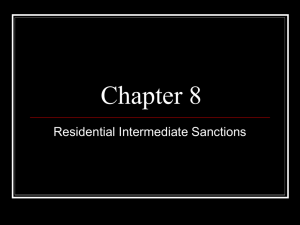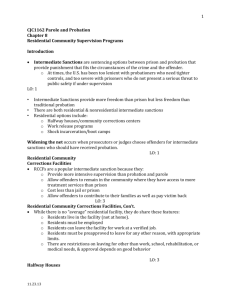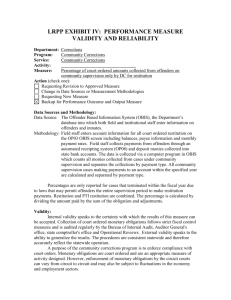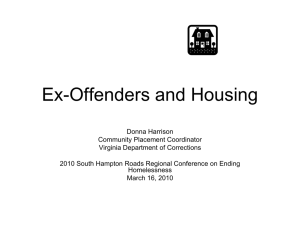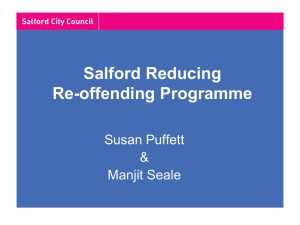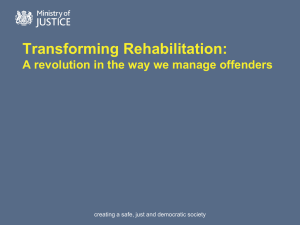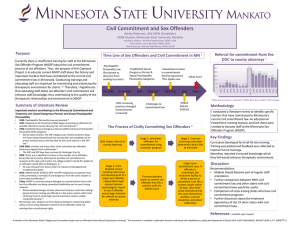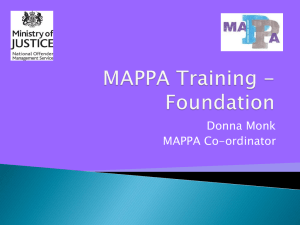Chapter 8
advertisement
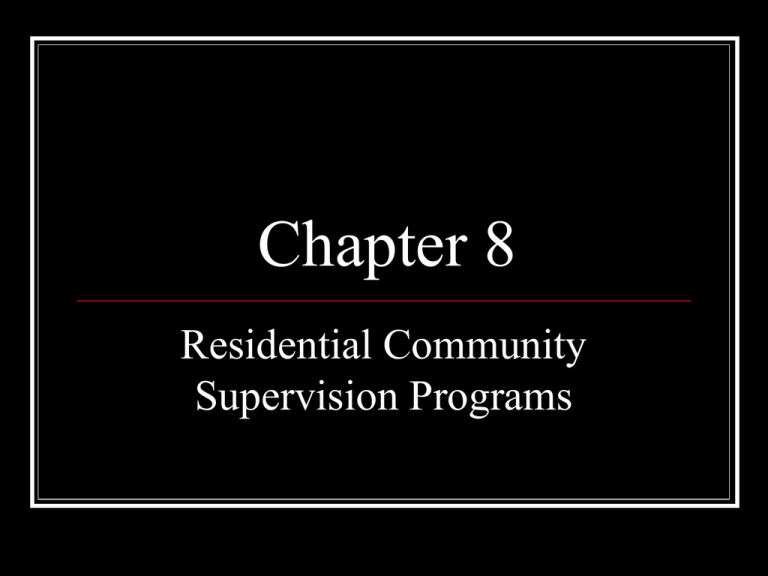
Chapter 8 Residential Community Supervision Programs Introduction Intermediate Sanctions are sentencing options between prison and probation that provide punishment that fits the circumstances of the crime and the offender. Widening the net occurs when prosecutors or judges choose offenders for intermediate sanctions who should have received probation. LO: 1 Residential Community Corrections Facilities RCCFs are a popular intermediate sanction because they: Provide more intensive supervision than probation and parole Allow offenders to remain in the community where they have access to more treatment services than prison Cost less than jail or prison Allow offenders to contribute to their families as well as pay victims back LO: 3 Residential Community Corrections Facilities, Con’t. While there is no “average” residential facility, they do share these features: Residents live in the facility (not at home). Residents can leave the facility for work at a verified job. Residents must be preapproved to leave for any other reason, with appropriate limits. LO: 3 Halfway Houses Halfway houses, also known as Community Corrections Centers, are staffed 24 hours a day, 7 days a week, and provide residential services for offenders who are either: “Halfway-in” or “Halfway-out” LO: 4 Halfway Houses, Con’t. Halfway houses date back to the early 1800s in England and Ireland, and originated in the U.S. in 1816. After only partial previous success, halfway houses received government assistance for the first time in the 1960s. LO: 4 Halfway Houses, Con’t. Levels System: A Form of Behavior Modification Increased freedom must be earned, based on: good behavior the amount of time in the program Workers at a halfway house are either: Custody-oriented or Responsible for treatment and rehabilitation LO: 4 Evaluation of RCCFs Evaluations of RCCFs typically examine program success or failure rates by comparing recidivism of residents with a matched sample of probationers or parolees. Evaluations conclude: Treatment participation by residents is critical to success. Clients that did not use drugs, had skill sets and community ties were more successful. Clients who were younger, used drugs and alcohol and with more extensive criminal histories were more likely to fail. RCCF clients are more successful than high risk parolees, but just the opposite with low risk offenders. LO: 2 Shock Incarceration Shock incarceration refers to a brief period of imprisonment that precedes a term of supervised probation and is variously referred to as: Shock probation Shock parole Intermittent incarceration Split sentence Boot camp LO: 3 Correctional Boot Camps After beginning in Georgia in 1983, Boot camps were the most common form of shock incarceration from 1983-late 1990s. Eligible offenders generally: Are first-time felony offenders Have been convicted of a nonviolent offense Fall within a certain age group Meet certain physical requirements LO: 4 Types of Boot Camps The two main types of boot camp programs are: Prison Boot Camps Probation/Jail Boot Camps Programs are typically 90-180 days before graduation to probation or parole supervision LO: 3 Criticisms Criticisms of boot camps are: They widen the net The confrontational style may have potentially negative consequences Problems with staff retention Evaluations of boot camp effectiveness examine: Attitude or behavioral change Decrease in institutional crowding Reduction in budget costs LO: 2 Other Types of Residential Community Corrections Facilities Restitution Centers Therapeutic Communities Work and Study Release Women Offenders Living with Children LO: 4 Supervising Offenders Who Are Mentally Ill Responses to offenders with mental illnesses in the community include: Mental health courts Specialized caseloads Outpatient treatment Residential treatment LO: 3 Drug and Alcohol Offenders According to Steiner (2004), supervision obstacles include: Identifying quality drug treatment programs with trained staff Being able to refer clients to a community-based program (due to space availability) Limited ability to keep offenders in treatment Relapse prevention LO: 3 Therapeutic Communities (TCs) TCs focus on the long-term treatment of alcoholism and drug addiction and abstinence from substances for criminal offenders. TCs are generally better suited for long-term poly-drug addictions. Drug courts are geared toward moderate forms of addiction. LO: 4 RCCFs for Women Offenders Most women are nonviolent property or drug offenders, and do not pose a threat to the community. Therefore, most women felons do not require prison sentences and would be ideal candidates for community placement. Many programs exist for women to live in with their children while serving sanction. LO: 4 Work Release Work release could be considered both a type of institutional corrections and a community corrections program. The traditional use of work release is much more restrictive than the halfway house environment because offenders are not allowed to leave the facility for any other reason except work and school. LO: 4 Restitution Centers Restitution centers are a type of residential community correctional facility specifically targeted for work-capable offenders who owe victim restitution or community service. A restitution center is a halfway house that is less restrictive than a work release center in that it permits residents to visit family, attend church, and go to the store or treatment. LO: 4
